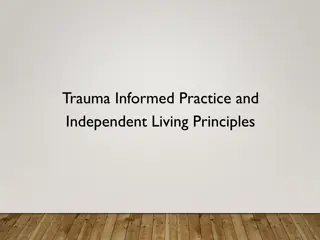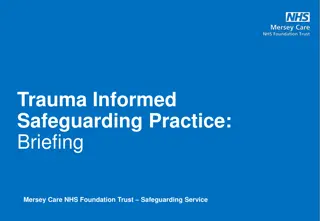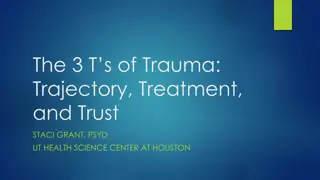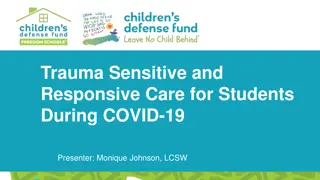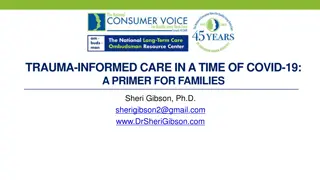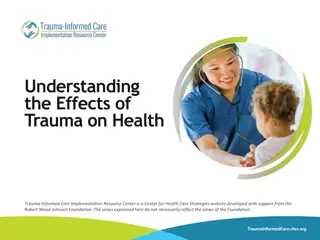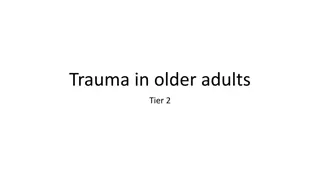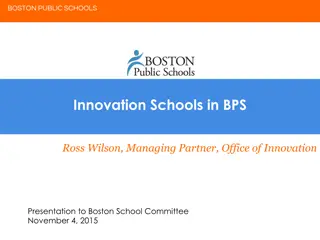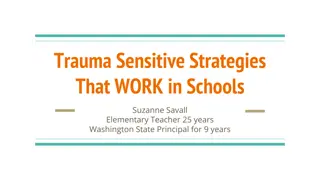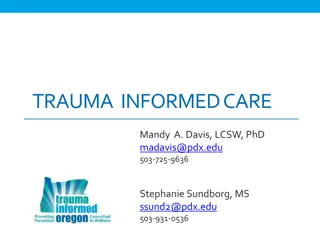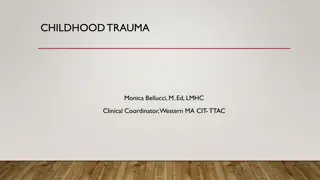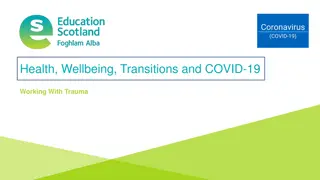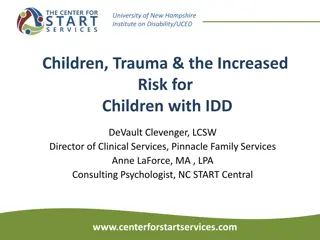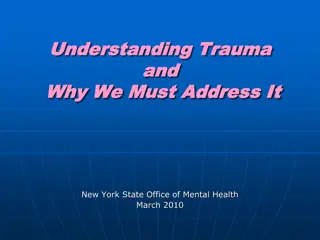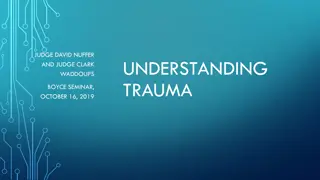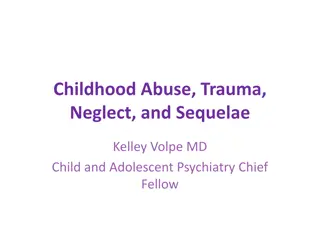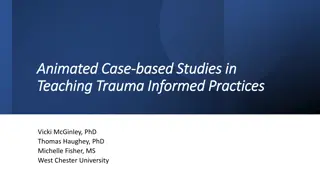Trauma Sensitive Schools within VTSS
How trauma-sensitive schools in the VTSS framework focus on social-emotional competencies, behavioral expectations, and embedding skills within their teaching matrix. Learn about specific behaviors, curriculum development, and trauma-sensitive thinking to create a safe and supportive learning environment.
Uploaded on Feb 23, 2025 | 0 Views
Download Presentation

Please find below an Image/Link to download the presentation.
The content on the website is provided AS IS for your information and personal use only. It may not be sold, licensed, or shared on other websites without obtaining consent from the author.If you encounter any issues during the download, it is possible that the publisher has removed the file from their server.
You are allowed to download the files provided on this website for personal or commercial use, subject to the condition that they are used lawfully. All files are the property of their respective owners.
The content on the website is provided AS IS for your information and personal use only. It may not be sold, licensed, or shared on other websites without obtaining consent from the author.
E N D
Presentation Transcript
Trauma Sensitive Schools within VTSS TFI 1.3 Behavior Expectations TFI 1.8 Classroom Procedures
What We Will Know and Do 1.3 Understand social emotional competencies and how to embed those within the matrix. Action Plan: School-wide matrix to include social emotional competencies.
1.3 Behavioral Expectations TFI: School has five or fewer positively stated behavioral expectations and examples by setting/location for student and staff behaviors (i.e., school teaching matrix) defined and in place. Mental Health Planning Tool: The school teaching matrix includes social-emotional skills. A-TFI: Evidence-based curricula are organized into clearly defined learning objectives and progressions that are aligned to state standards.
Our Curriculum? We develop these common expectations through the common practice of developing the teaching matrix. Consistent instruction across multiple programs and settings within the school Communication among staff members and students Students know what to expect and what is expected in all areas Consistent communication with parents Makes the hidden curriculum visible
Specific Behaviors/ Social- Emotional Skills BE SAFE: Keep hands and feet to self BE SAFE: Tell an adult when I am worried about a friend. BE RESPECTFUL: Use the signal to ask a public or private question BE RESPECTFUL: Make sure everyone gets a turn BE RESPONSIBLE: Turn in all work on time BE RESPONSIBLE: Check in with my feelings during the day.
Trauma Sensitive Thinking Think: lack of skill, not intentional misbehavior Think: building missing skills, not shaming for lack of skills Think: nurture, not criticize Think: teach, not blame Think: discipline, not punishment
What If? We are focused on specific ways that everyone teaches social emotional skills across ALL settings and content areas...everyday!!! ...and we use our data to prioritize the skills we teach .
Installing SEL curricula within the Framework of VTSS What does the data say? (community demographics, screening info. attendance patterns, discipline patterns, climate surveys, family members deployed, family members impacted by drug use, domestic violence, calls to crisis centers, etc.)
Focus on Social Emotional Skills Please see your VTSS Systems Coach for the video
SEL Competencies Self-Awareness - Recognize one s own feelings, interests, strengths and limitations Self-Management - Regulate emotions and manage daily stressors Social Awareness - Take perspective of others and appreciate similarities and differences Relationship Skills - Exhibit pro-social behavior and demonstrate positive social skills in order to develop meaningful relationships Responsible Decision Making - Make ethical decisions and strengthen the ability to develop appropriate solutions to identified problems
How do we include social- emotional skills in our matrix? Identify locations where you can teach SEL in your ALREADY EXISTING lesson plans Embed in current matrix Add an expectation around trauma Be Resilient Be Resourceful Be Supportive Be Inclusive Add a SELF column/location
Matrix: Review matrix/lesson plans TEACHING MATRIX All Settings Classrooms Hallways Cafeteria Be kind Give your best effort Hands/feet to self Use normal voice volume Practice good table manners RESPECT Help/share with others Recycle Participate in activities Clean up after self Replace trays & utensils RESPONSIBLE Walk Follow adult instructions Be alert to your surrounding Maintain physical space SAFE Clean up eating area
Matrix: Specific Behaviors SETTING > All Settings Classrooms Hallways Cafeteria Be kind Give your best effort Hands/feet to self Use normal voice volume Practice good table manners RESPECT USE POSITIVE SELF-TALK Help/share with others Recycle Participate in activities Clean up after self Replace trays & utensils RESPONSIBLE Walk MONITOR FEELINGS/ EMOTIONS USE CALMING STRATEGIES Follow adult instructions Be alert to your surrounding Maintain physical space SAFE Clean up eating area ASK FOR HELP
Matrix: Core Value SETTING > All Settings Classrooms Hallways Cafeteria Be kind Hands/feet to self Give your best effort Use normal voice volume Practice good table manners RESPECT Help/share with others Recycle Participate in activities RESPONSIBLE Walk Replace trays & utensils Clean up after self IDENTIFY EMOTIONS COMMUNICATE IF THERE IS A PROBLEM USE RELAXATION STRATEGIES RESILIENT USE COPING STRATEGIES ASK FOR HELP
Matrix: Self Column SETTING > SELF All Settings Classrooms Hallways Cafeteria Be kind USE Hands/feet to self Give your best effort Use normal voice volume Practice good table manners POSITIVE SELF-TALK Respect Help/share with others MONITOR FEELINGS/ EMOTIONS Recycle Participate in activities Replace trays & utensils Responsible Walk Clean up after self USE CALMING STRATEGIES Be alert to your surrounding ASK FOR HELP Follow adult instructions Clean up eating area Safe Maintain physical space
Action Planning - 1.3 Review your current matrix Make a list of social-emotional skills you want to prioritize Identify places where you can teach social- emotional skills within your current matrix If you are using an SEL curriculum for Tier 1, how can you align the lessons/language with your matrix? What next steps do you need to take to update or revise your matrix?
Trauma Sensitive Schools within VTSS TFI 1.8 Classroom Procedures
What We Will Know and Do 1.8 Understand the importance of relationships for students who have experienced trauma Identify strategies to foster the development of positive relationships between all stakeholders Gain an understanding of how trauma can impact students in the classroom Explore key classroom practices and understand how the practices support students impacted by trauma Action plan around classroom practices as well as stakeholder communication
1.8 Classroom Procedures TFI: Tier 1 features (school-wide expectations, routines, acknowledgements, in-class continuum of consequences) are implemented within classrooms and consistent with school-wide systems. Mental Health Planning Tool: Educators are knowledgeable of and use strategies that promote SEL and relationships between educators and student, student to student, educators to educators and connections between children and families and schools. A-TFI: Evidence-based practices and routines are implemented with fidelity and consistency across all classrooms (e.g. activating prior knowledge, explicit instruction, engagement, feedback, scaffolding).
Relationships We know the research from Hattie around relationships shows an effect size of .73 on student achievement, thus relationships are the key to success in the classroom, especially for students who have experienced trauma.
Importance of Relationships You can obtain a copy of this video through your VTSS Systems Coach.
It all starts with Relationships Activity: Using the padlet, list practices/activities that you use to support building positive relationships between staff, leadership, students and families.
Ways to Connect Two by Ten - for ten days in a row, spend two minutes talking to a student about anything except school Daily Check-in and Check-outs - brief interaction between student and an adult Community Building circles - use a circle format to get to know one another in the classroom, discuss topics, have shared experiences.
Importance of other connections Student - Student Staff - Staff School - Family Leadership - Staff
Trauma in the Classroom For many children who have experienced traumatic events, the school setting can feel like a battleground in which their assumptions of the world as a dangerous place sabotage their ability to remain calm and regulate their behavior in the classroom.
How Does Trauma Impact Students in the Classroom? Executive Functioning Language and Communication Skills Memory Ability to see Cause and Effect Organizational Ability Concentration and Attention Descriptions that follow largely based on Rodenbush, K. (2015). The effects of trauma on behavior in the classroom included in Education Northwest A Practitioner s Guide to Educating Traumatized Children
VTSS Top 10 Physical Environment Active Supervision Define Classroom Expectations Routines and Procedures Opportunities to Respond Formative Assessment Scaffolding Acknowledgement and Behavior Specific Praise Error Correction Building Community Through Feedback
Physical Environment Provide a sense of safety, calm, and security reduce triggers create welcoming space
Considerations Improve Lighting: use small lamps, fluorescent covers, dinner switch Reduce Noise: tennis balls on chairs Improve visuals: post positive messages, reduce clutter, consider furniture arrangement and traffic patterns, use agendas Bring in Nature: have plants, use a water feature, have pictures of landscapes and nature Establish Calming Areas: quiet space, chair, sensory materials
Establishing a Sense of Safety Focus on positive relationships Practice active supervision Incorporate a class meeting structure Define, teach, and acknowledge appropriate behavior Class expectations and norms Establish routines and procedures that support Social Emotional Learning
Classroom Matrix SETTINGS TEACHING MATRIX All Settings Classrooms Hallways Cafeteria Be kind Give your best effort E X P E C T A T I O N S Hands/feet to self Use normal voice volume Practice good table manners Respect USE POSITIVE SELF-TALK Help/share with others Recycle Participate in activities Clean up after self Replace trays & utensils Responsible MONITOR FEELINGS/ EMOTIONS Walk USE CALMING STRATEGIES Follow adult instructions Clean up eating area Be alert to your surrounding Safe Maintain physical space ASK FOR HELP
Considerations for Routines and Procedures to support SEL Manage stress Celebrate differences Emotional check-ins Explore various cultures and perspectives Group and individual problem solving
Classroom Matrix: Routines Classroom Procedures SETTING > SMALL GROUP INSTRUCTION HOW TO ASK FOR HELP WHEN I FEEL UPSET/ FRUSTRATED RAISE HAND OR USE PRIVATE SIGNAL TO GAIN TEACHERS ATTENTION LISTEN TO PEERS WHEN THEY SPEAK COMMUNICATE WITH TEACHER/ADULT RESPECT USE KIND WORDS USE KIND WORDS WAIT FOR TEACHER ACKNOWLEDGEME NT RESPONSIBLE KEEP UP WITH YOUR MATERIALS IDENTIFY EMOTION WALK WHEN MOVING AROUND THE CLASSROOM SAFE USE QUIET VOICE USE COPING STRATEGY
Action Planning 1.8 How will you facilitate the development of positive relationships with all stakeholders? What will you add/change to your classroom practices to make them more trauma sensitive?










